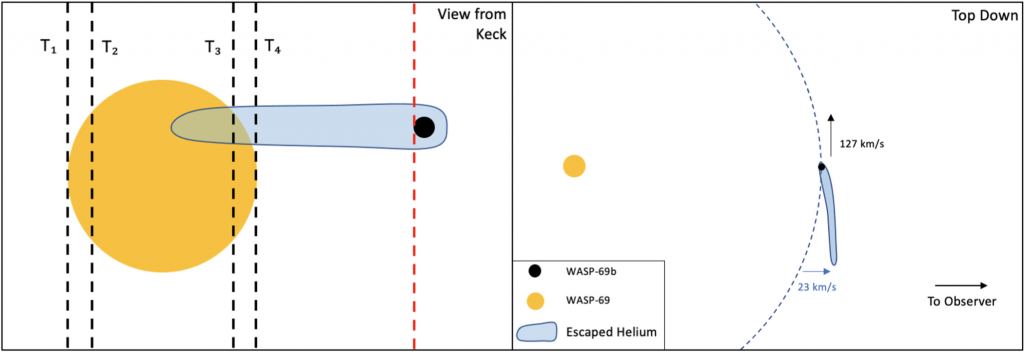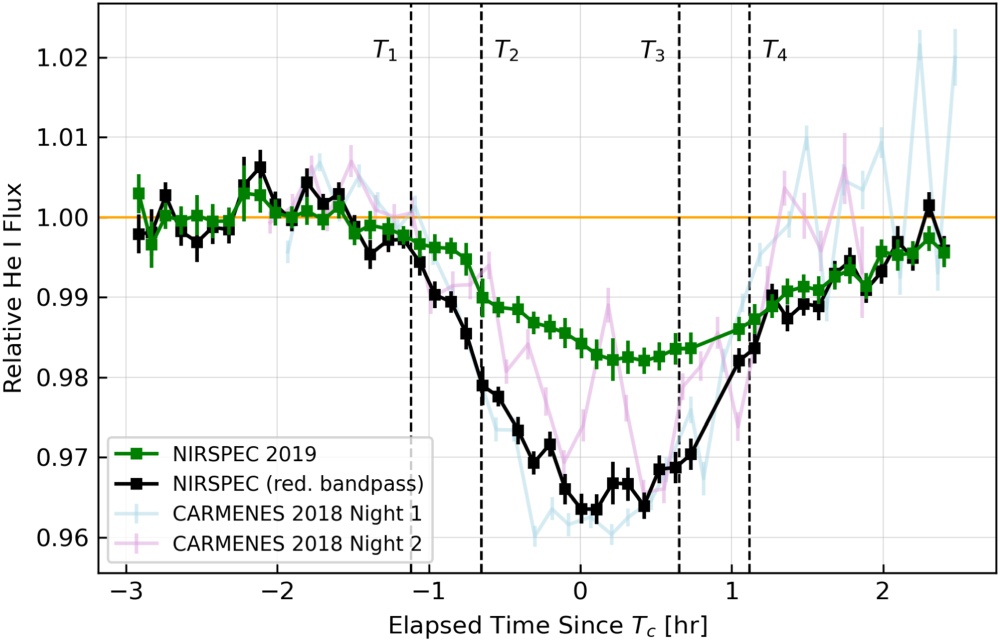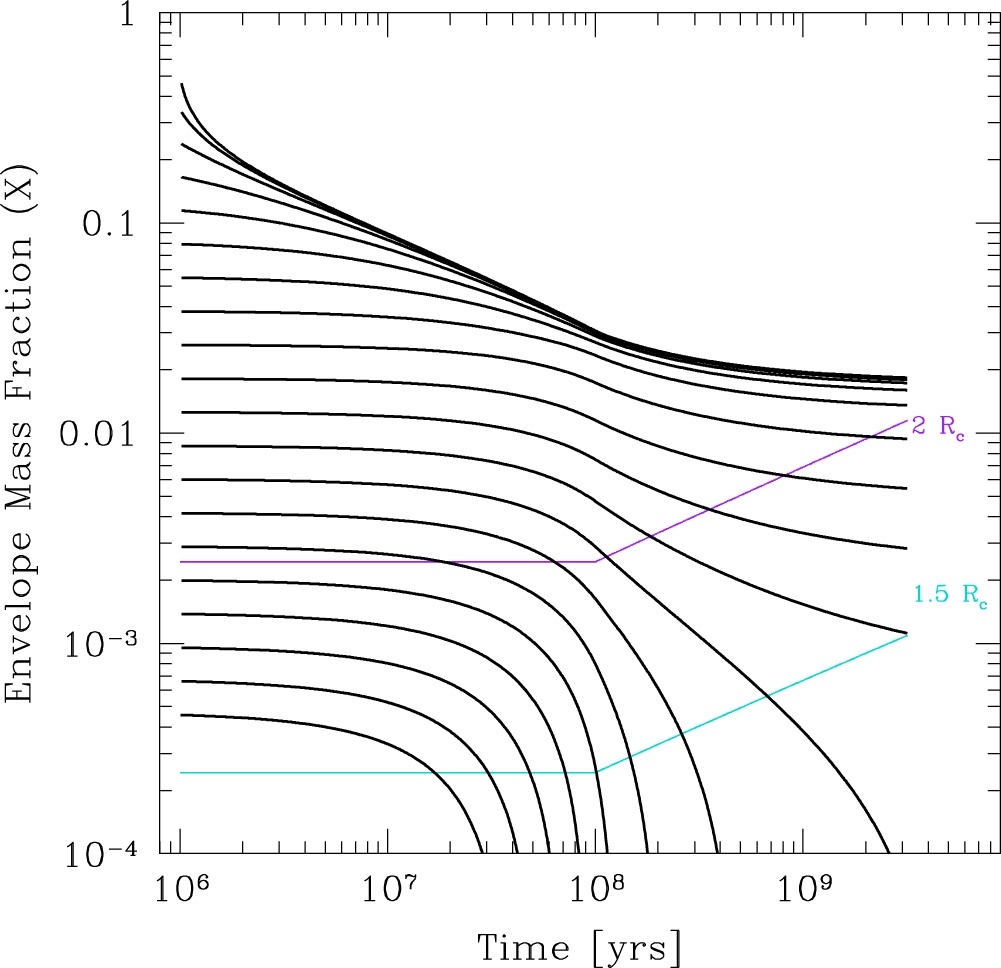About 164 light-years away, a Hot Jupiter orbits its star so closely that it takes fewer than four days to complete an orbit. The planet is named WASP-69b, and it’s losing mass into space, stripped away by the star’s powerful energy. The planet’s lost atmosphere forms a trail that extends about 560,000 km (350,000 miles) into space.
Scientists know that stars can strip mass from planets that get too close. It’s called mass loss, and it’s driven by extreme UV (EUV) and/or X-ray energy from a star and by the stellar wind. It’s not a rare phenomenon, even though researchers don’t fully understand it.
But seeing the actual stream of gas coming from the planet is a rare opportunity to study mass loss.
Researchers have known about WASP-69b’s predicament and have predicted how much of the planet’s atmosphere is being stripped away. Previous research even identified a very small, subtle tail. But new research shows that the tail, which would stretch from Earth to well beyond the Moon in our Solar System, is much longer than previously thought.
The new research is titled “WASP-69b’s Escaping Envelope Is Confined to a Tail Extending at Least 7 Rp.” It’s published in The Astrophysical Journal. The first author is Dakotah Tyler, a doctoral student in the Department of Physics and Astronomy at UCLA.
“Work by previous groups showed that this planet was losing some of its atmosphere and suggested a subtle tail or perhaps none at all,” said first author Tyler. “However, we have now definitively detected this tail and shown it to be at least seven times longer than the planet itself.”
As we began to detect more and more exoplanets with NASA’s Kepler mission, followed by the TESS mission, something became apparent. There are gaps in the exoplanet population. The Neptunian Desert refers to the dearth of Neptune-sized planets on two to four-day orbits around their stars. The Small Planet Radius Gap refers to a dearth of exoplanets with radii between 1.5 and 2 times Earth’s radius. Scientists think that mass loss plays a role in both phenomena, and it’s unlikely that there’s a lack of exoplanets that form in the Gap and the Desert.
But the details of atmospheric loss are not well understood. WASP-69b and its extended tail of stripped gas give astronomers a rare opportunity to study it more closely.
“Studying the escaping atmospheres of highly irradiated exoplanets is critical for understanding the physical mechanisms that shape the demographics of close-in planets,” the authors write in their paper.
Previous researchers found the tail, so Tyler and his co-authors knew where to look. But Tyler and the other researchers used a much larger telescope for their observations. They used the 10-meter telescope at the Keck Observatory and its high-resolution spectrograph, NIRSPEC. They found that the stream, which is primarily hydrogen and helium, is much longer than thought.

“Over the last decade, we have learned that the majority of stars host a planet that orbits them closer than Mercury orbits our sun and that the erosion of their atmospheres plays a key role in explaining the types of planets we see today,” said co-author and UCLA professor of physics and astronomy Erik Petigura. “However, for most known exoplanets, we suspect that the period of atmospheric loss concluded long ago. The WASP-69b system is a gem because we have a rare opportunity to study atmospheric mass-loss in real-time and understand the critical physics that shape thousands of other planets.”
There are two different forces at work here. Radiation from the star and the stellar wind. Both forces work together to strip away WASP-69b’s and then shepherd it away. The tail is a direct result of how both of those forces work together.
“These comet-like tails are really valuable because they form when the escaping atmosphere of the planet rams into the stellar wind, which causes the gas to be swept back,” Petigura said. “Observing such an extended tail allows us to study these interactions in great detail.”
Neutral hydrogen is really hard to see, so the researchers measured the Helium in the tail and used it to estimate the overall mass loss from the planet. One of the reasons that previous research found a smaller tail is because the telescope they used is smaller. Larger telescopes gather more photons from whatever they’re observing. The figure below compares the current research, done with a larger telescope, with the previous observations. Both show helium light curves.

The researchers say that the star is losing about one Earth mass of material every 100 million years. But WASP-69b is a massive gas giant of about 0.29 Jupiter’s mass. This means that it would take an awfully long time to be reduced to nothing.
But it’ll never be reduced to nothing, according to the authors.
“At around 90 times the mass of Earth, WASP-69b has such a large reservoir of material that even losing this enormous amount of mass won’t affect it much over the course of its life. It’s in no danger of losing its entire atmosphere within the star’s lifetime,” Tyler said.
Exoplanets may also stabilize once they’ve been reduced to a specific mass. Some research shows that exoplanets with atmospheres that are double the radius of their core are the most stable and resist atmospheric loss. If the atmosphere is larger than this, then the planet is susceptible to atmospheric erosion and will eventually reach the more stable state outlined above. For planets with smaller atmospheres than this, runaway atmospheric loss is likely.

This new research is based on fairly brief observations. The authors point out that there’s likely more variability in the system that changes the mass loss rate over time. Understanding the variability is critical to understanding the mass loss in more detail.
“Repeat observations are valuable to probe any variability in the outflow properties, especially with different instruments,” they conclude.

